人教精通版英语5下五年级下册Lesson19
- 格式:docx
- 大小:14.69 KB
- 文档页数:2
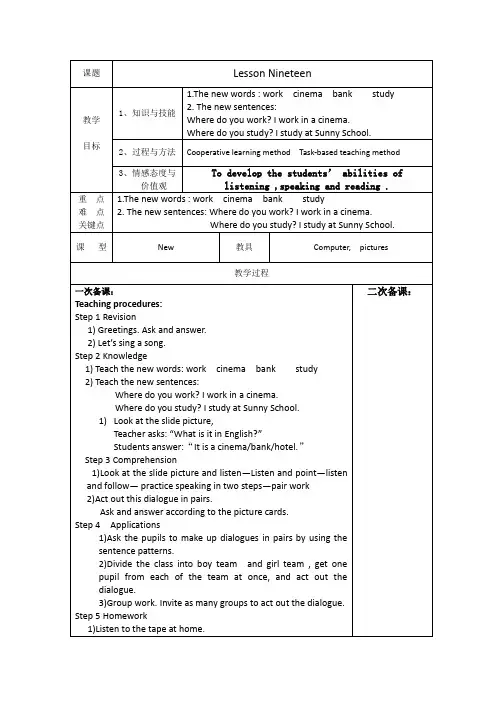
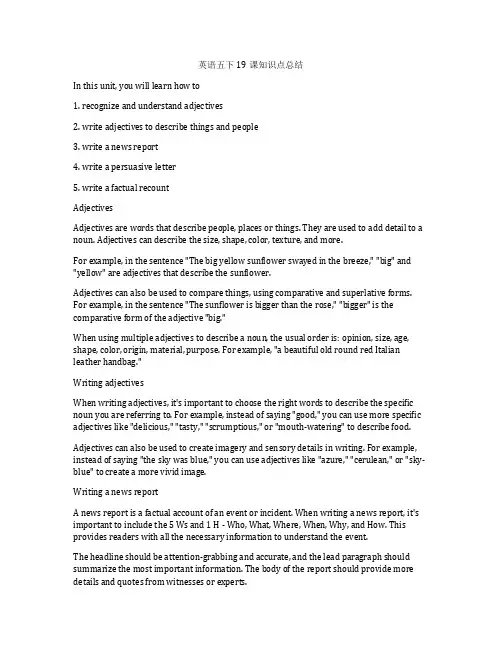
英语五下19课知识点总结In this unit, you will learn how to1. recognize and understand adjectives2. write adjectives to describe things and people3. write a news report4. write a persuasive letter5. write a factual recountAdjectivesAdjectives are words that describe people, places or things. They are used to add detail to a noun. Adjectives can describe the size, shape, color, texture, and more.For example, in the sentence "The big yellow sunflower swayed in the breeze," "big" and "yellow" are adjectives that describe the sunflower.Adjectives can also be used to compare things, using comparative and superlative forms. For example, in the sentence "The sunflower is bigger than the rose," "bigger" is the comparative form of the adjective "big."When using multiple adjectives to describe a noun, the usual order is: opinion, size, age, shape, color, origin, material, purpose. For example, "a beautiful old round red Italian leather handbag."Writing adjectivesWhen writing adjectives, it's important to choose the right words to describe the specific noun you are referring to. For example, instead of saying "good," you can use more specific adjectives like "delicious," "tasty," "scrumptious," or "mouth-watering" to describe food.Adjectives can also be used to create imagery and sensory details in writing. For example, instead of saying "the sky was blue," you can use adjectives like "azure," "cerulean," or "sky-blue" to create a more vivid image.Writing a news reportA news report is a factual account of an event or incident. When writing a news report, it's important to include the 5 Ws and 1 H - Who, What, Where, When, Why, and How. This provides readers with all the necessary information to understand the event.The headline should be attention-grabbing and accurate, and the lead paragraph should summarize the most important information. The body of the report should provide more details and quotes from witnesses or experts.The language should be clear, concise, and objective. Stick to the facts and avoid including personal opinions or biases.Writing a persuasive letterA persuasive letter is written to convince the reader to take a specific action or change their mind about something. When writing a persuasive letter, it's important to clearly state your position and provide strong arguments to support it.Use emotive language to appeal to the reader's emotions, and provide evidence to back up your claims.Address any potential counterarguments and explain why your position is the most logical and beneficial.End with a strong call to action, such as asking the reader to support a cause, make a donation, or participate in an event.Writing a factual recountA factual recount is a straightforward retelling of events. When writing a factual recount, it's important to include all the relevant details in chronological order.Use past tense and simple, clear language. Ensure that the events are presented accurately, without any personal opinions or interpretations.Provide specific details like dates, times, locations, and names of people involved.End the recount with a conclusion that summarises the main events and their significance. In conclusion, this unit focuses on the use of adjectives to describe people, places, and things. It also teaches students how to write a news report, a persuasive letter, and a factual recount. These skills are essential for effective communication and writing in various contexts. By mastering these skills, students will be able to express themselves more accurately and persuasively in their writing.。


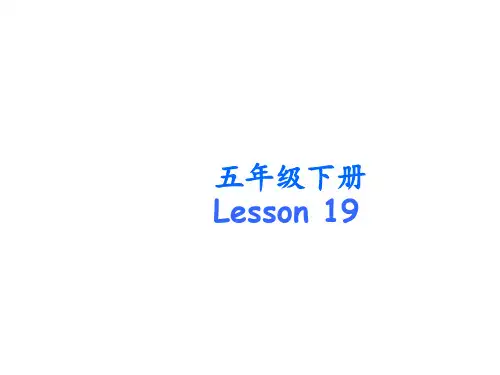
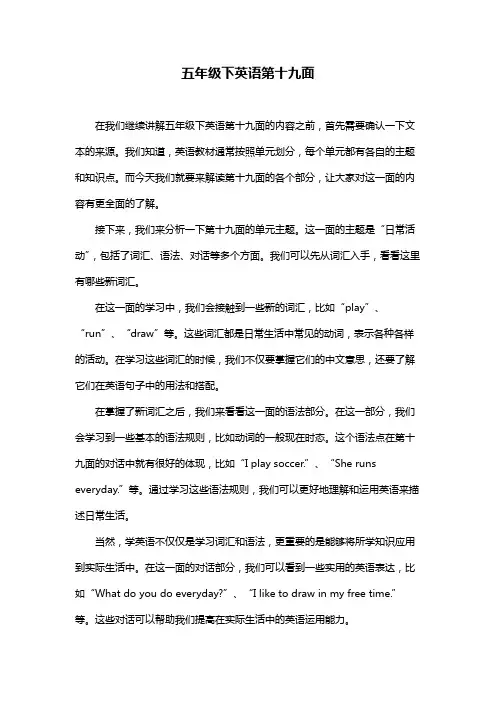
五年级下英语第十九面在我们继续讲解五年级下英语第十九面的内容之前,首先需要确认一下文本的来源。
我们知道,英语教材通常按照单元划分,每个单元都有各自的主题和知识点。
而今天我们就要来解读第十九面的各个部分,让大家对这一面的内容有更全面的了解。
接下来,我们来分析一下第十九面的单元主题。
这一面的主题是“日常活动”,包括了词汇、语法、对话等多个方面。
我们可以先从词汇入手,看看这里有哪些新词汇。
在这一面的学习中,我们会接触到一些新的词汇,比如“play”、“run”、“draw”等。
这些词汇都是日常生活中常见的动词,表示各种各样的活动。
在学习这些词汇的时候,我们不仅要掌握它们的中文意思,还要了解它们在英语句子中的用法和搭配。
在掌握了新词汇之后,我们来看看这一面的语法部分。
在这一部分,我们会学习到一些基本的语法规则,比如动词的一般现在时态。
这个语法点在第十九面的对话中就有很好的体现,比如“I play soccer.”、“She runs everyday.”等。
通过学习这些语法规则,我们可以更好地理解和运用英语来描述日常生活。
当然,学英语不仅仅是学习词汇和语法,更重要的是能够将所学知识应用到实际生活中。
在这一面的对话部分,我们可以看到一些实用的英语表达,比如“What do you do everyday?”、“I like to draw in my free time.”等。
这些对话可以帮助我们提高在实际生活中的英语运用能力。
为了让大家更好地巩固所学知识,这里还有一些练习题供大家自测。
比如:1.用一般现在时态填空:- I _____ (play) soccer every weekend.- She _____ (run) five kilometers every morning.2.根据图片完成对话:A: _____ do you do after school?B: I _____ (draw) pictures.完成了这些练习题之后,我们可以总结一下第十九面的重点内容:学习了新词汇、掌握了基本语法规则,以及掌握了一些实用的英语对话。
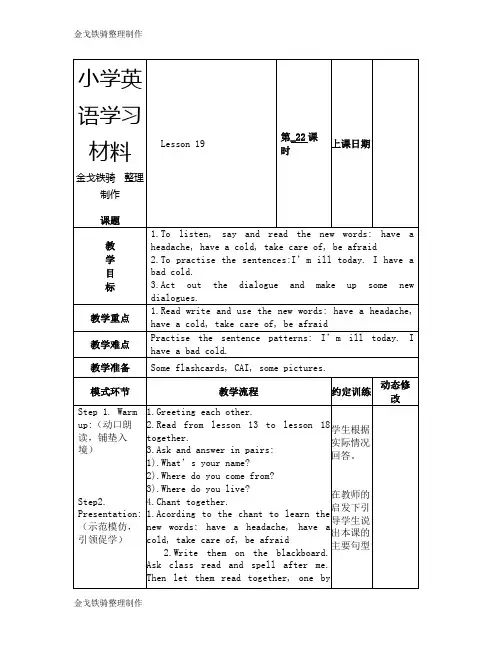
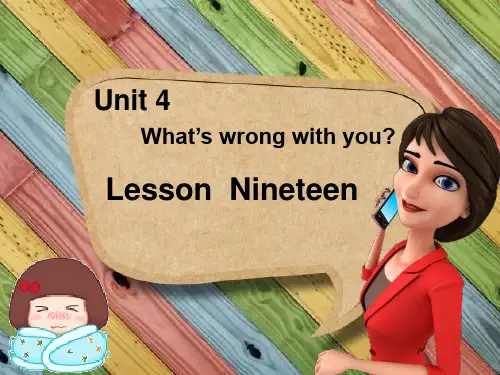
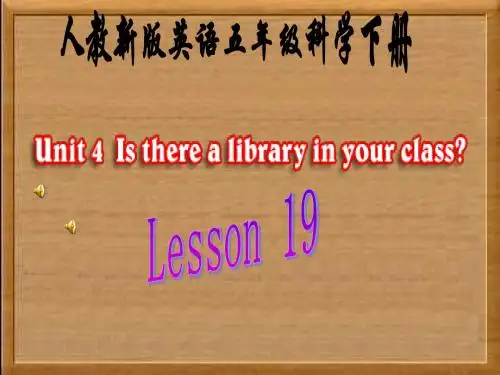
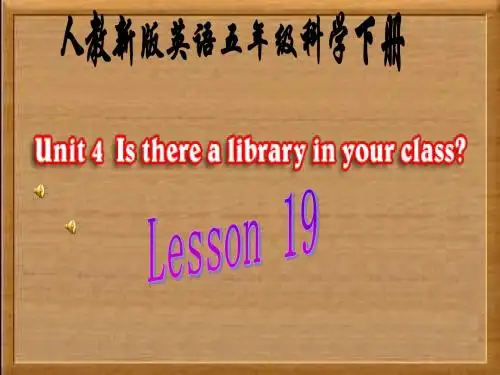
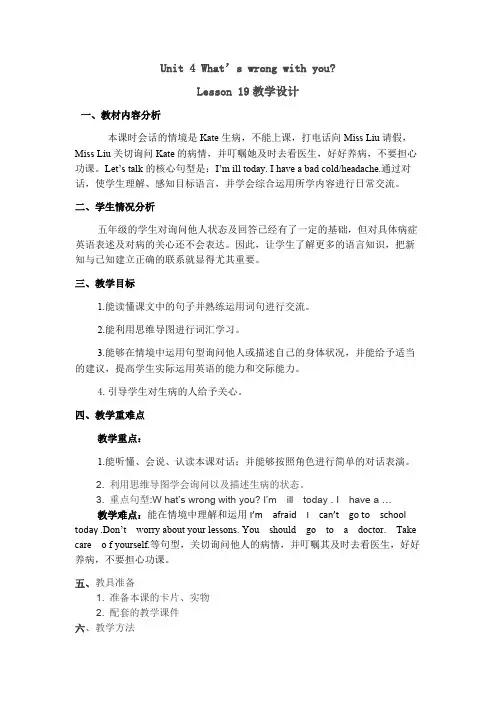
Unit 4 What’s wrong with you?Lesson 19教学设计一、教材内容分析本课时会话的情境是Kate生病,不能上课,打电话向Miss Liu 请假,Miss Liu关切询问Kate的病情,并叮嘱她及时去看医生,好好养病,不要担心功课。
Let’s talk的核心句型是:I’m ill today. I have a bad cold/headache.通过对话,使学生理解、感知目标语言,并学会综合运用所学内容进行日常交流。
二、学生情况分析五年级的学生对询问他人状态及回答已经有了一定的基础,但对具体病症英语表述及对病的关心还不会表达。
因此,让学生了解更多的语言知识,把新知与已知建立正确的联系就显得尤其重要。
三、教学目标1.能读懂课文中的句子并熟练运用词句进行交流。
2.能利用思维导图进行词汇学习。
3.能够在情境中运用句型询问他人或描述自己的身体状况,并能给予适当的建议,提高学生实际运用英语的能力和交际能力。
4.引导学生对生病的人给予关心。
四、教学重难点教学重点:1.能听懂、会说、认读本课对话;并能够按照角色进行简单的对话表演。
2. 利用思维导图学会询问以及描述生病的状态。
3. 重点句型:W hat’s wrong with you? I’m ill today . I have a …教学难点:能在情境中理解和运用I’m afraid I can’t go to school today .Don’t worry about your lessons. You should go to a doctor. Take care o f yourself.等句型,关切询问他人的病情,并叮嘱其及时去看医生,好好养病,不要担心功课。
五、教具准备1. 准备本课的卡片、实物2. 配套的教学课件六、教学方法1. 教法:在采用任务型教学的同时,应用思维导图教学法、情境教学法、TPR教学法等。
五年级下册英语教案Unit 4 Lesson 19 | 人教精通版教学目标1. 知识目标:学生能够掌握本课的关键词汇和基本句型,如“library”, “dictionary”, “borrow”, “return”等,并能够运用这些词汇和句型进行简单的英语对话。
2. 能力目标:培养学生运用英语进行日常交流的能力,提高他们的听说技能,同时增强学生的自主学习能力。
3. 情感目标:激发学生对英语学习的兴趣,培养他们的合作意识和跨文化交际意识。
教学内容本课主要围绕图书馆的场景展开,教学内容包括图书馆中常见的物品名称,如“book”, “magazine”, “newspaper”等,以及借阅和归还图书的常用表达,如“How can I borrow this book?”和“When should I return it?”。
教学重点与难点教学重点:词汇的掌握和句型的运用。
教学难点:正确使用借阅和归还图书的句型,以及相关词汇的拼写和发音。
教具与学具准备教具:多媒体设备,教学课件,图书卡片。
学具:学生用书,笔记本,彩色笔。
教学过程1. 课堂导入:通过展示图书馆的图片,引导学生谈论他们在图书馆的经历,激发学生的学习兴趣。
2. 新知呈现:利用多媒体展示本课的词汇和句型,配合实例进行讲解和示范。
3. 互动练习:组织学生进行角色扮演,模拟图书馆的借阅和归还场景,加强实际运用能力。
4. 巩固提升:通过小组活动,让学生运用所学知识创作小对话或小故事,提高他们的语言运用能力。
板书设计板书将包括本课的关键词汇、句型以及相关的语法点。
词汇和句型将以图表和例句的形式呈现,以便学生更好地理解和记忆。
作业设计1. 书面作业:完成课后练习题,巩固词汇和句型。
2. 口头作业:与家长或同伴进行英语对话,练习本课所学内容。
3. 拓展作业:查找有关图书馆的英语资料,如图书的分类、借阅规则等,拓宽知识面。
课后反思课后,教师应反思教学效果,评估学生的学习情况,并根据学生的反馈调整教学方法和策略,以提高教学效果。
小学英语学习材料
金戈铁骑整理制作
Lesson 19
一、知识和能力目标
1、能够听、说、读、写以下短语: thank you , have a cold, go to school, don’t worry以及单词:ill , bad , cold , thank , head 。
2、能够听懂问句:May I speak to Miss Liu? Do you have a cold? 并能回答问句。
3、能够理解Just speak对话部分的含义。
二、教学重点、难点
1、重点是掌握I’m ill today. I have a bad cold. Thank you. 句子的含义及用法。
2、难点是对This is Liu speaking. 的理解和用法的掌握。
三、课前准备
1、单词和短语的ppt课件;
2、对话部分的flash视频课件。
四、教学步骤
1、热身
(1)复习学过的一些与日常生活有关的生活用品名称;
(2)对话练习:When do you go to school/have breakfast/go to bed… ?
2、新课呈现
(1)利用ppt课件学习Unit 6的单词和短语。
(2)用Do you have a … ?加深对所学重点生词的熟练程度。
(3)让学生根据自己的时间,对刚刚所学的单词进行练习。
(4)介绍重点句型:May I speak to Miss Liu? This is Liu speaking. Do you have a cold? Yes , I have a bad cold. 及用法。
(5)组织学生模仿上列句型进行对话。
(6)利用flash课件演示对话,并让学生进行模仿练习。
(7)学生二人一组配合flash课件演示对话,逐步熟悉对话内容,重点掌握I’m ill today . I have a headache. Do you have a cold? Yes , I have a bad cold.句型和理解领会May I speak to Miss Liu? This is Liu speaking. Take good care of youself. 的含义。
(8)帮助和引导学生理解本部分内容。
作业布置:
(1)课堂作业:练习册P.
46“听一听”、“选一选”P.
47
“译一译”。
(2)家庭作业:练习册P.
46
“写一写”。
板书设计
Lesson 19
Kate doesn’t feel well today.
She can’t go to school.
She calls her teacher, Miss Liu.
May I speak to Miss Liu, please?
This is Miss Liu speaking.。